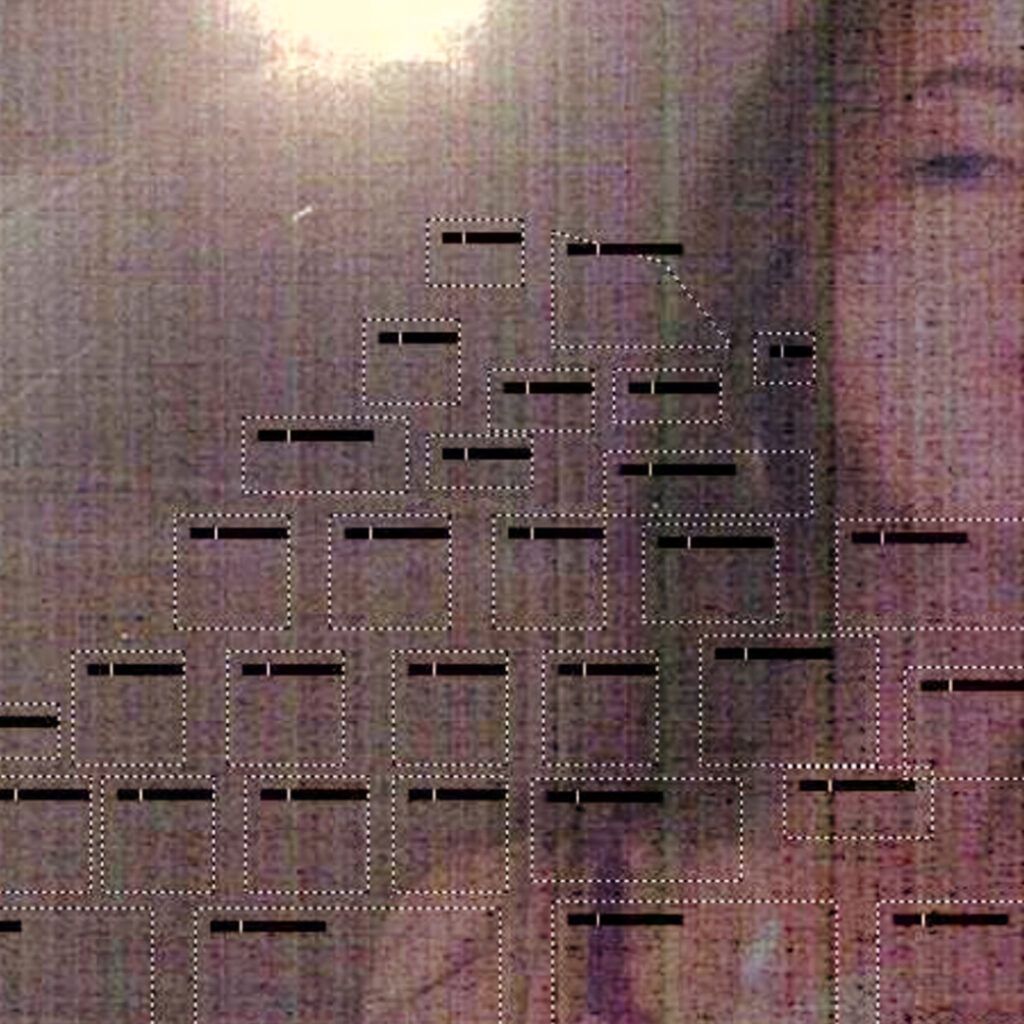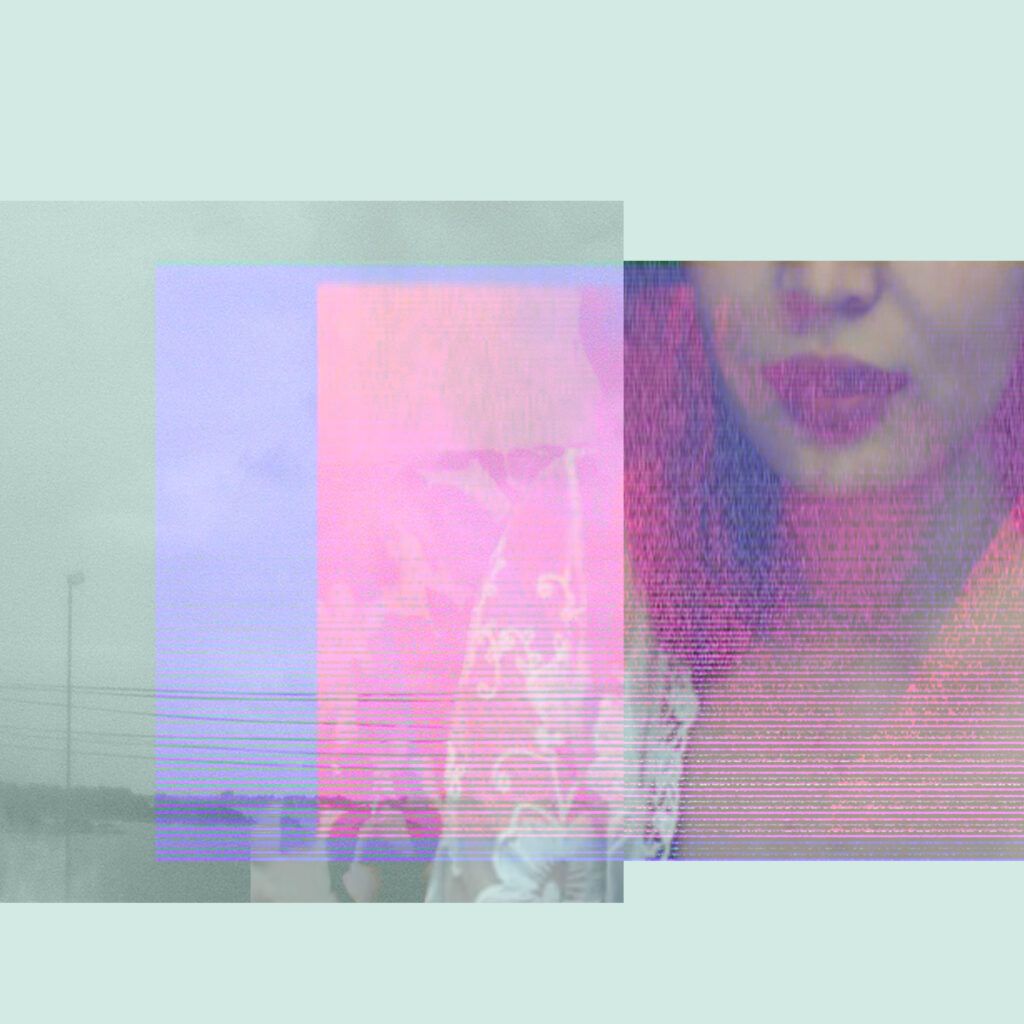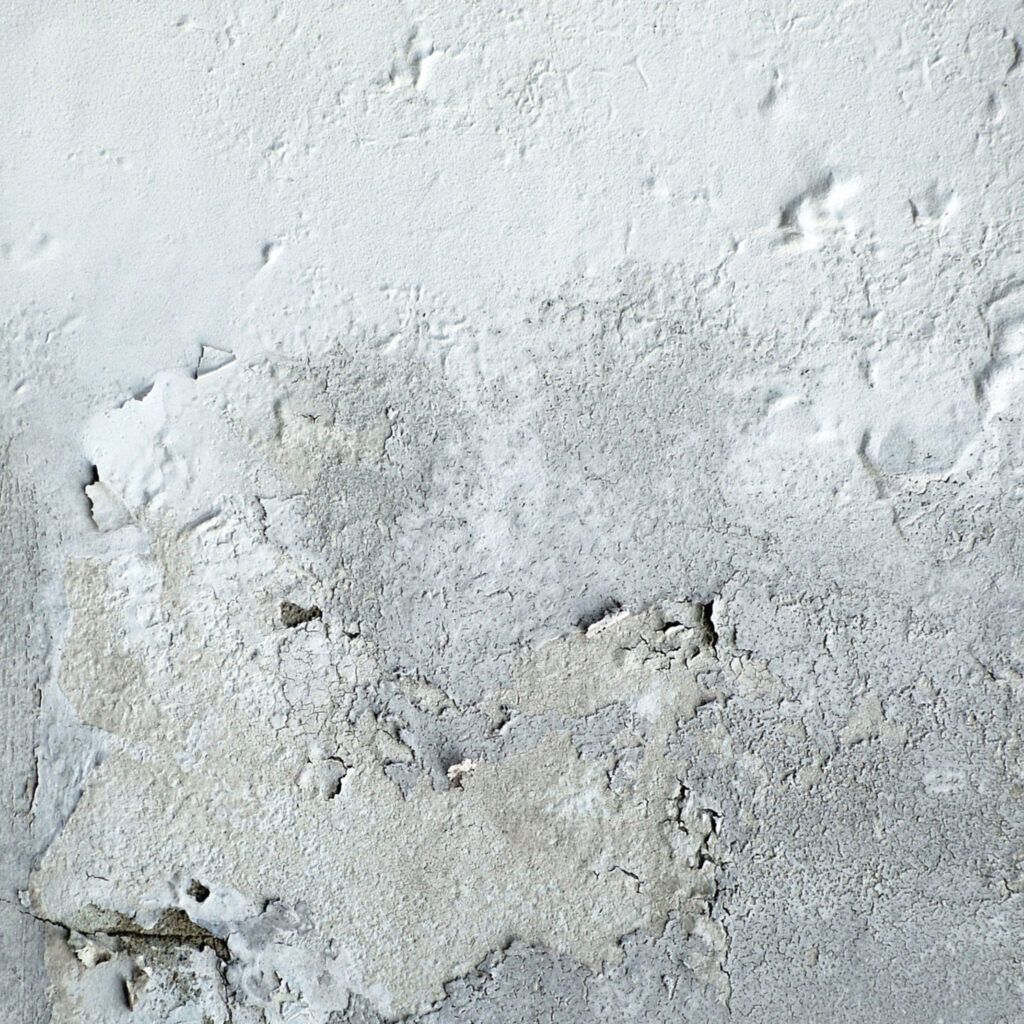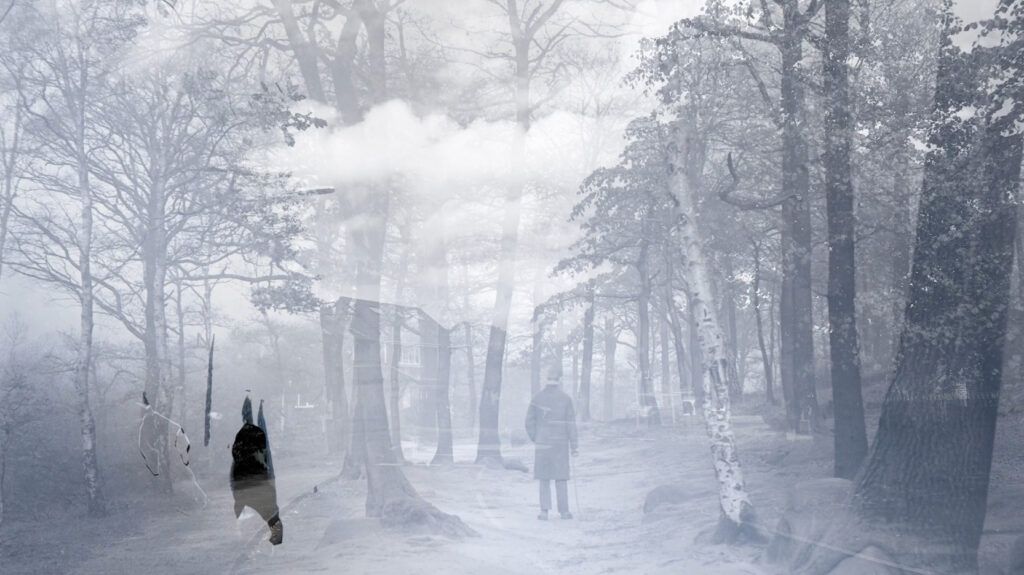MICHAEL C COLDWELL
The Noise made by Ghosts

I’m a ghost hunter. I seek out the weird and the eerie, the ghoulish and the creepy. I take photographs in the dark and I make audio recordings of haunted spaces. But in my work, the dead come back to life not as disembodied spirits or poltergeists, but as phantomatic traces in the technologies of reproduction themselves. I scour obsolete media and damaged recordings for lost fragments and ambiguous forms. From these traces I construct new experimental art and music. From shortwave radio to faded archival photographs to lo-fi webcam feeds, I find these strange ghosts populating the background noise of everyday devices. They can be very fleeting and vague. Sometimes they are captured residues of the real, and sometimes they are more akin to hallucination, but it can be hard to determine which phenomenon is being experienced, at any given time. The spectrality of media is ubiquitous, as Jacques Derrida noted many decades ago, but it is only when the technology fails in its routine illusion of presence, that we perceive commonplace facsimilia as the uncanny.
“spectrality… far from being reduced by the rationality of modern technology, found itself, on the contrary, amplified, as if this medium (photocinematography, teleperception, telecommunication) was the very site, the proper element, of a fantastical phantomaticity… Every culture has its phantoms and the spectrality that is conditioned by its technology.”
Jacques Derrida (2010) Copy, Archive, Signature

Such spectrality is not limited to past media forms and archival relics, although it certainly becomes more apparent as time passes and media decays. The Ghost in the MP3 is a fascinating project that deals with intrinsic spectrality from a more recent media history. Ryan Maguire, at the Virginia Center for Computer Music, salvaged the bits of audio discarded by this lossy file codec, creating unnerving and glitchy soundscapes that certainly fit into what Mark Fisher described as the “technological uncanny”. We hear scraps of the familiar and the organic, disembodied and distorted by machines, rendering what was once pop music, alienating and inhuman.
The noise we are hearing is actually the hidden processes of an everyday medium, made audible. We strain to find something recognisable in the mechanistic din, isolate the strangely familiar, spectres then emerge and haunt us – but we have been here before. The odd glitches and audio artefacts are not entirely unknown to us. These commonplace machines have already broken countless times. Our ears remember even if we think we have forgotten. And the way these machines malfunction gives them a certain time-stamp, an unconscious association with memory, which transports us back to our first encounters with electronic clairvoyants, mesmerised as we were, by their magical ability to transport us through time and space. Just as the clattering whirr of a Super 8 projector, fizzy bad-tracking on an old VHS tape, or the high whine of a polaroid developing, may take us back to fond childhood memories of such media, so might the compression artefacts of MPEG Layer 3, finally haunt the nostalgics of the future.

There are lot of theories about what such unintended noise might mean in our cultural texts – the principal one is that noise means nothing, it’s merely rubbish, and it is actually the inverse of meaning. At best, it is a distraction from the actual messages we can glean. Noise cannot be imagined or symbolised in the normal way, and could lie within the Lacanian order of the Real – that which exists physically but which cannot be expressed within our systems of understanding and communication. Noise is that which thwarts communication – it could even be its opposite, rather than silence, which often has rather more to say than a racket. Audio recording can capture something of this ‘Real’ more readily than the image: the “waste or residue that neither the mirror of the imaginary nor the grid of the symbolic can catch: the physiological accidents and stochastic disorder of bodies” (Kittler, 1999, 15-16). Noise may be too complex, random or chaotic for us to comprehend, but when we succumb to it as an experience, it can still have meaning projected onto it, by us as listeners. In The Metaphysics of Crackle (2013) Mark Fisher discusses how the background hiss of tape, or the scrunch of worn vinyl, can come to symbolise the temporal disjuncture between the listener and the sound. It could not only remind us of a period when that specific time-stamped medium was more common, but signify decay and the passing of time itself. We become aware that we are not co-present with what we are listening to anymore, that its presence in present space is an illusion – that the sound must be a ghost of something else, sometime else – brought to us by time machine – by a disembodying machine – the background noise of which, makes us feel media’s buried spectrality.
Noise reduction exists to maintain modern media’s perfected illusions of presence. Hauntology, then, should exist to reveal its underlying absences and deceptions.
Under the name Conflux Coldwell (or CC) I release music I have made whilst ghost hunting with various crap devices. If you were to apply such noise reduction to my album AM (2017), the whole record would probably disappear. The music was made using only three analogue radios, in various states of disrepair. I had fond memories of scanning longwave radio as a child, searching the static for distant signals. When I decided to return to DXing nearly 30 years later, there was a lot more noise than signal to be found. AM radio seemed to be dying. Searching for stations felt too much like ghost hunting now. Did I really hear that? Is there anything out there to be found at all? And the noise lost its fragile connections to nostalgic memory, and began to symbolise nothingness again.
As a piece of unsuccessful historical research, AM documented my (almost total) failure to record what are often known as “numbers stations” – enigmatic shortwave broadcasts featuring odd signals, children reading out random number strings, pulses, beacons and peculiar musical elements. Some of these stations have been broadcasting non-stop since the Cold War, and are routinely hypothesised as being a form of untraceable coded communication, used by spies operating in the field. Where they really come from and why some are still running, is largely unknown. I managed to capture glimpses of them in the endless white noise and miscellaneous communications chatter, thanks to an online resource known as Priyom, which logs and publishes this bizarre RF activity. These mysterious broadcasts certainly felt like Fisherian temporal disjunctures, hauntological anomalies, anachronistic interlopers, drifting through the aether from a bygone era. They somehow felt even more ghostly as utilised in AM’s failed documentation, very faint signals drowning in static, playing weird tricks on the ear. I began to think there was a deeper psychological relationship between ghosts and noise, that needed to be investigated further.

Background noise and interference can not only form a hauntological breaking of time, in the way described by Fisher, but also an eerie disjuncture in space. The noise and scraps of numbers stations captured for AM may have sounded like ghosts from the Cold War, but they were broadcast live as I recorded them from the other side of the world. The ghosts were a part of the present moment, if not a part of that local space. Signals of unknown origin invade the home from some unidentified “Other”, the big outside beyond. They pass through walls undetected and whisper words into our domestic machines. Once again, it is the background noise which reminds us that this is a rather strange thing to be happening. We are so used to spectres in our homes now, we no longer notice them, until some malfunction shines a light on their unrealness.
For Virtual Private Broadcast, I adopted a similar methodology to AM, but this time I turned my ghost-hunting equipment onto a more contemporary medium – webcams. I was particularly interested in cameras that had been left on and broadcasting their grainy images of nothing-much, to nobody in particular. Many of the cameras seemed dark and silent until the gain was turned up on both sound and vision – then odd forms crept out of the pixelated noise floor and into my music. Strange voices from outside the frame, weird digital artefacts and quiet background pop songs, garbled beyond all recognition by compression algorithms, struggling to reproduce anything at all. There is a technological and aesthetic similarity with Ryan Maguire’s work here – a comparable spectrality is at play, as the technology is stretched to breaking point.

The disjuncture here is certainly spatial rather than temporal, but the result is no less haunting. There is a profound distance felt between listener and noise, despite this being a technology designed to bring people together – a salve for loneliness. Many of the unsecure feeds I found were sexcams that hadn’t been turned off between shows – unsettling lo-fi surveillance of empty rooms and empty beds. The people involved were certainly real and present somewhere, but the machines had seemingly rendered them ghosts in real-time.
The project raised many questions it couldn’t answer, regarding the voyeurism of the post-digital gaze, privacy concerns in the age of omnipresent cameras and the ethics of appropriating such materials to make art. What the project did unearth, however, was that the hauntedness of media had as much to do with the psychological disjunctive effects of technology and noise, as it did any reanimation of the dead or nostalgia for past forms. Neither of these hauntological tropes were particularly present in Virtual Private Broadcast, yet the phenomenological spectrality experienced was effectively the same.

All recording technologies, whether audio or visual, spectralise what they capture, turning physical beings and real world objects into disembodied forms, traces which persist long after the actual moment represented has passed. This is the crucial point of disjuncture, but most contemporary media technology performs this seamlessly enough, and we’re very used to information machines doing this for us now, after over a century of them underpinning almost every aspect of culture. Noise can be an affecting reminder of the non-presence of the trace it carries, but it fulfils another role in these hauntings too. Noise is a catalyst for pareidolia and other apophenia.

These psychological phenomena are behind many ghost sightings and paranormal encounters. Apophenia is an umbrella term covering a myriad of examples of our propensity to find patterns and meaning in random noise, or ambiguous information. We’ve all seen faces in the dark that aren’t there – that’s pareidolia, and it is common enough. Charles Bonnet syndrome is rarer: a psychophysical disturbance experienced by blind people – the brain takes scraps of meaningless visual information and paints elaborate pictures, hallucinations that seem completely real to the sufferer. Audio equivalents exist too, such as EVP (Electronic Voice Phenomenon), where voices are heard in noisy recordings that aren’t there. Many believe they are the voices of the dead captured on tape, but the haunting of this noise is all happening in the mind. On another album entitled Prisoner’s Cinema (2016), I used some of these ideas to inspire new electronic drone music. The name was taken from another interesting example of pareidolia, in which inmates kept in solitary confinement begin to experience strange light shows all around them, a result of the brain trying to cope with extreme sensory deprivation.
The original inspiration for this work came from a cheap baby monitor. Having a new child puts you on high alert, constantly searching for signs of catastrophe. In the noisy crackles beamed to us from the silent nursery by this device, my partner and I often heard odd sounds and hissing voices, only to find our little one fast asleep, when we ran upstairs to investigate. Once our children were too old to need such vigilant monitoring, I repurposed the equipment for my ghost hunting experiments, many of which were used for the music on Prisoner’s Cinema.
Whether we hear or see such spectres in the noise largely depends on whether we’re actively searching for them. The power of suggestion is very strong in this regard, and we can prime the brain to find the patterns we want in random data. A good audio example of this is the Brainstorm VS Green Needle video, which did the social media rounds in 2018. By saying either “brainstorm” or “green needle” in your head, before hearing the toy emit a sound, you can make the indefinite noise heard form into either of those words (or even combinations of those phonemes).
Audio lends itself well to this, as sound can often be ambiguous without visual cues. This apophenic power of suggestion is not limited to hearing, however, and many visual artists have utilised similar psychology in their work. In Tacita Dean’s The Green Ray (2001), 16mm analogue film is projected, purportedly capturing the elusive “green ray” of the setting sun. While this is an actual optical phenomenon caused by refraction of the dying sunlight, the green ray is hard to spot and has taken on something of a mythical status. In Dean’s work we watch the sun set in real-time, trying to catch sight of this spectacle. Sometimes it seems like we saw it, other times we’re just watching footage of the sun setting. Dean claims we can only see this phenomenon on the original grainy celluloid, and so watching a digital reproduction is pointless. Yet still, we try. We convince ourselves we’ve seen something. Whether or not the ray is there, Dean has made us watch very intensively, and we then see an everyday occurrence quite differently. She has made us meditate on vision itself, and think about the unique material qualities of analogue film and the elusive ghosts it can contain – and all because she told us to stare into the void for two minutes.

If such work makes us question the veracity of our own senses in the lived moment, memory is much more plastic and misleading than perception. The unreliability of human memory has been a major catalyst for technological development over the centuries, as we devise ever-more precise mnemonic prosthetics to do our remembering for us. While the simple photograph may contain greater detail than most organic recollections, it captures such a thin sliver of time, that we must rely on the imaginary to re-remember anything via the image. Even film and video, which use a series of such stills to simulate natural time passing (capturing more than just isolated static moments), have their limitations and distortions, when used as memory aids. The moving image is unreliable in the opposite direction, incessantly moving, cutting and fading between times, jumbling memories together, creating false juxtapositions and deleting key scenes. We cannot focus on authentic recollected moments, as we are swept-up by the mesmeric spectacle of machine memory. This creeps into human memory itself, rewriting it slowly over time. Looking back to distant childhood, I’m sometimes not sure whether I’m remembering reality, dreams, or films I saw back then. This is another key psychological phenomenon, sometimes referred to as paramnesia. It is similar to pareidolia in that it is a by-product of the brain trying to make sense of incomplete traces and ambiguous forms. The imaginary is involved in the same way again too, creating hallucinations to fill in the ever-increasing gaps in the ‘data’. I investigated this in another Conflux Coldwell project called Zoetrope.space. In this work, my ongoing research into media spectrality was channelled into concerns of personal memory, forgetting and mis-remembering the past. I searched for cartoons, films and television programmes I could barely remember from early childhood, and sampled particularly haunting moments, looping them up as new audiovisual artefacts. The tape loops were further processed to simulate their fuzziness in my own mind – cutting away any narrative context and foregrounding the background noise as I had before.
I then paired the wrong audio loops with the video clips to recreate the confusing sense of paramnesia I experience when trying to recollect this distant time. These new works then seem to overwrite their sources in my head, creating new false layers of mediated memory. This a particularly uncanny experience for me personally, as these are my own memories being manipulated and erased – but the strange disjunctive quality of these loops points towards something more universal regarding noise, spectrality and memory. This work can be situated alongside William Basinski and The Caretaker, conceptual music that deals directly with the medium’s ability to address and distort the fragility of human recollection. It is our jarring realisation of media as the loss of memory, rather than its retention, which truly haunts us in these works. The noise signals memory decay and erasure, reminding us that, in the fullness of time, both minds and machines will forget everything we once held dear.
Cultural memory can be affected in this way as much as personal memory – this too was dealt with by Jacques Derrida in Archive Fever (1996).
The structure of the archive is spectral
(Derrida, 1996: 84)
In the book we begin to see how the archive erases as much as it preserves, suffering from what Derrida called “acute hypomnesia”. The archive takes place at the “originary and structural breakdown of the said memory” (Derrida, 1996: 11) – the very act of preservation through selection, repetition, reproduction and reimpression, distorts and even destroys any authentic memories it seeks to embalm – only vestigial traces of them outlive the moment of internment – and those traces are always subject to recontextualization in ever-changing narratives and political agendas, set by those in charge of management and curation. My own research into media spectrality lead to a series of interventions in the archive, to investigate the dimensions of this hypomnesia, and see if anything could be done to rehabilitate the ghosts that this engendered.
In The Remote Viewer (2018) video installation, old photographs of my home town were projected over the same scenes as they exist today, revealing vast changes over the last century, and creating tantalising glimpses back in time. But both the city and the archive used were shown to be texts under profound erasure. Many of the glass plate negatives had been stored incorrectly and had become damaged or completely unreadable. The cellulose nitrate negatives were in an even worse state, as the archive team rushed to try and digitise as much of this rapidly decaying collection as they could, before the artefacts fell apart forever. The files created, captured and preserved this state of degeneration, in a strange digital stasis. I used this visual data in the work, attempting to take the images back to where they were originally shot, using the scant textual information logged with the decaying slides. These damaged traces created haunting views of lost landscapes, with their “noise” playing a similar role to what it had done in Zoetrope – noise as a visceral reminder of loss, a memento mori for memory itself.

As well as revealing archival hypomnesia and the haunting temporal disjunctures of the photographs themselves, the work touched upon hauntology’s political potential – the act of raising ghosts, challenging the archive and revealing hidden histories and lost cultural memory. The spectropolitics invoked here regarded the absent voices and hidden trauma of slum clearance in the city. One of the areas explored by The Remote Viewer was an urban district which had seen multiple waves of mass demolition over the last century. The old photographs I used had actually been taken by local government, to make the original case for clearance. The photographs supposedly demonstrating how “unhealthy” the area was, essentially demonising it, in order that the authorities could clear the entire sector. These images and the hidden working class history they reveal, is dealt with in a fabulous book by John Tagg, called The Burden of Representation (1988). A chapter is dedicated to this particular archive and the ways in which the photographs were used rhetorically, rather than as genuine evidence, to suit the political agenda of those in power. Despite the fact that many of the images contain no people, and the buildings already look uninhabitable, the houses were still occupied at the time of shooting. The photographers were also instructed to underexpose the images they took, and focus on the worst areas of the district, to reinforce the message. There are a few images that contain representations of the residents who were displaced without their consent – many of whom were Jewish and Irish immigrants, living in poverty. There was certainly a racial dimension to this mass deportation, but that too is lost in these records. In the images that contain people we see children peering out of broken windows and groups playing in the street. These are the real ghosts in the work.

Taking them back to where they came from felt like a political act of rehabilitation and reappropriation. Projecting the ghosts into an area of the city which is still contested, still being gentrified, and in which racism is still rife, also felt like a critical intervention to make. The work initiated some interesting discussions on memory and the changing city, with those that attended its exhibition, but it still felt that any noise made by these ghosts was a resounding silence, and their voices had been lost forever.
The problem with spectropolitics is that ghosts are always something of an illusion, always part-imagined and part-mediated traces of a lost past – disturbing but also illusive patterns emerging from the noise of history. That noise is certainly real and material, but the ghosts we see or hear in it can be unconscious interpretations of the chaos we perceive, originating as much from inside ourselves, and our fragile memories, as from any material without. Acknowledging this fact, makes them no less powerful or affecting a phenomenon, but all the more enigmatic, problematic and ultimately impossible to pin down.
That’s why, despite these many failures, I can’t stop chasing ghosts.